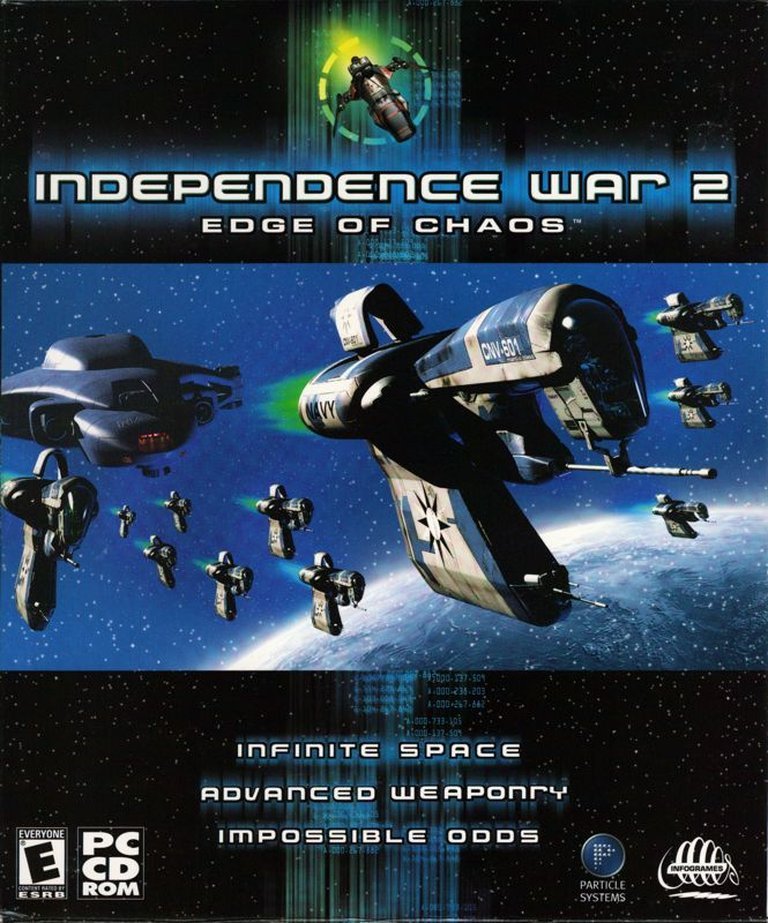- Release Year: 2001
- Platforms: Windows
- Publisher: Infogrames do Brasil Ltda., Infogrames Europe SA, Infogrames, Inc.
- Developer: Particle Systems Ltd.
- Genre: Action, Simulation
- Perspective: 1st-person
- Game Mode: LAN, Online PVP, Single-player
- Gameplay: Combat, Space flight, Trading
- Setting: Futuristic, Sci-fi
- Average Score: 81/100

Description
Independence War 2: Edge of Chaos is a space simulation game set in the Badlands cluster, a century after the first Independence War. The player takes on the role of the son of a miner who was killed by Caleb Maas, the owner of the Maas corporation, and seeks revenge with the help of a long-dead man’s mind trapped in a computer. The game features a redesigned user interface, a new graphics engine, online multiplayer support, and realistic physics, allowing players to fly four different ships, trade or steal goods, and engage in complex combat.
Gameplay Videos
Cracks & Fixes
Patches & Updates
Reviews & Reception
metacritic.com (83/100): A gorgeous and absorbing space combat sim, but one that takes time to get to grips with.
mobygames.com (79/100): A unique experience.
Independence War 2: Edge of Chaos: Review
Introduction
Independence War 2: Edge of Chaos is a seminal space combat simulator that has left an indelible mark on the gaming industry. Released in 2001 by Particle Systems and published by Infogrames, this game is the sequel to the original Independence War. With its complex gameplay mechanics, rich storyline, and realistic physics engine, Edge of Chaos has garnered a dedicated following and critical acclaim. This review will delve into the game’s development history, narrative, gameplay mechanics, world-building, reception, and legacy, providing a comprehensive analysis of its place in video game history.
Development History & Context
Developed by Particle Systems, a studio known for its innovative approach to game design, Edge of Chaos was initially conceptualized as a sequel to the original Independence War. The development team aimed to address criticisms of the first game, such as the lack of multiplayer and the rigid storyline. The game was developed for Windows-based PCs, with initial plans for release on PlayStation, Nintendo 64, and Dreamcast, though these console versions were ultimately cancelled. The dual-platform development influenced design decisions, such as the use of joystick hat controls and the limitation of saving between missions.
The gaming landscape at the time of Edge of Chaos’s release was characterized by a decline in the popularity of space sims. Despite this, Particle Systems was determined to create a game that would revitalize the genre. The studio drew inspiration from classic space sims like Elite and incorporated elements such as open-world exploration and complex gameplay mechanics.
Narrative & Thematic Deep Dive
Edge of Chaos is set in the 24th century, 100 years after the events of the first Independence War, in the Badlands Cluster, a region of space far removed from Earth and the Core Systems. The story follows Cal Johnston, the protagonist, as he seeks revenge against Caleb Maas, the corporate heir responsible for his father’s death. The narrative is characterized by its depth and complexity, with a richly detailed universe and a cast of compelling characters.
The game’s storyline is heavily influenced by the player’s actions, with multiple branching paths and a high degree of replayability. The narrative explores themes of piracy, rebellion, and the struggle against corporate tyranny, providing a nuanced and engaging story that immerses players in the world of the Badlands.
Gameplay Mechanics & Systems
Edge of Chaos features a complex and realistic physics engine, utilizing Newtonian mechanics to simulate space flight. The game allows players to command a variety of ships, each with its unique characteristics and capabilities. The gameplay mechanics are centered around space combat, piracy, and trade, with a high degree of freedom and flexibility.
The game’s control system is highly customizable, allowing players to tailor the controls to their preferences. The use of joystick hat controls and the incorporation of a flight computer assistance system make the gameplay more accessible to players.
World-Building, Art & Sound
The game features a richly detailed universe, with 16 star systems to explore and a vast array of space traffic and NPCs. The graphics engine, known as Flux, provides a visually stunning experience, with detailed ship models and realistic environmental effects.
The sound design is equally impressive, with a haunting soundtrack that complements the game’s atmosphere. The sound effects and voice acting add to the immersion, creating a believable and engaging universe.
Reception & Legacy
Upon its release, Edge of Chaos received widespread critical acclaim, with many reviewers praising its complex gameplay mechanics, rich storyline, and realistic physics engine. The game holds a Metacritic score of 83/100, indicating “generally favorable reviews.”
Despite its critical success, Edge of Chaos was not a commercial success, contributing to the eventual acquisition of Particle Systems by Argonaut Games. However, the game’s influence can be seen in subsequent space sims, and it remains a beloved classic among fans of the genre.
Conclusion
Independence War 2: Edge of Chaos is a landmark game that has left a lasting impact on the space sim genre. Its complex gameplay mechanics, rich storyline, and realistic physics engine make it a standout title that continues to be celebrated by gamers and critics alike. While it may not have achieved commercial success, its influence can be seen in many subsequent games, and it remains a testament to the innovation and creativity of Particle Systems. As a piece of video game history, Edge of Chaos is a must-play for fans of space sims and anyone interested in exploring the evolution of game design.